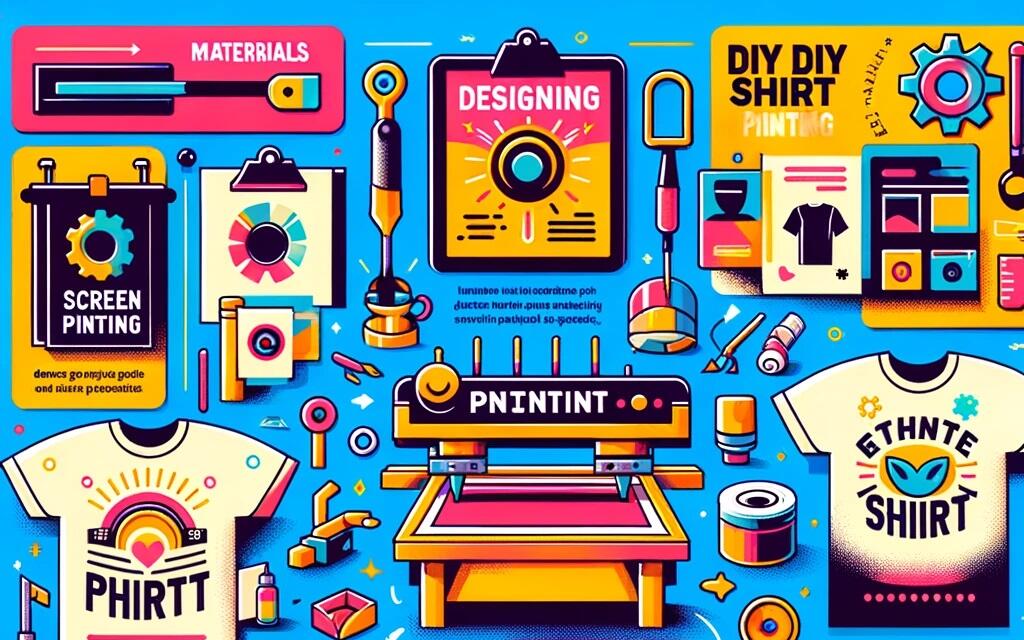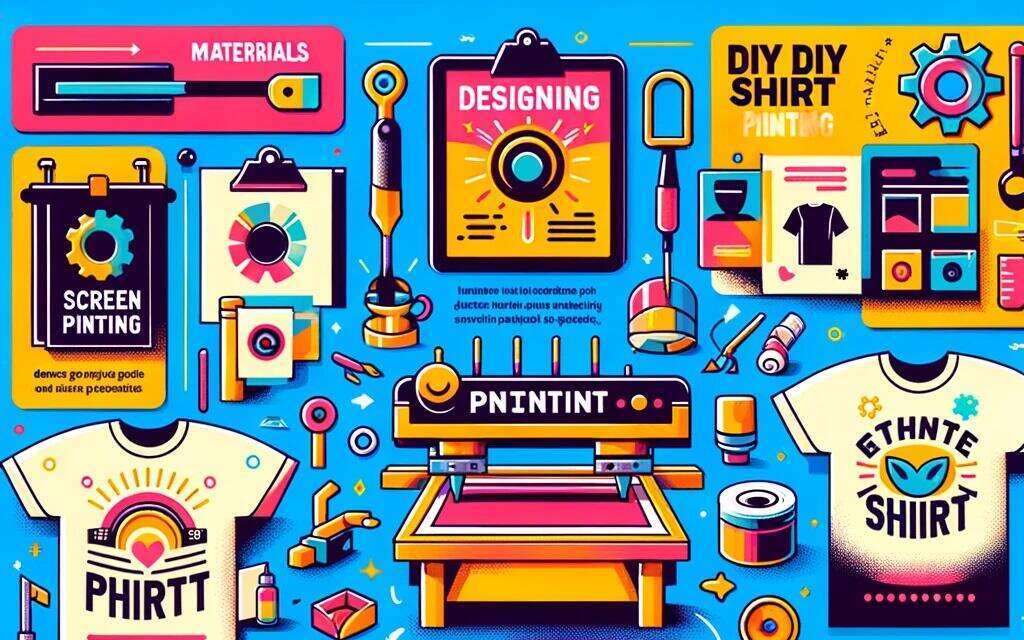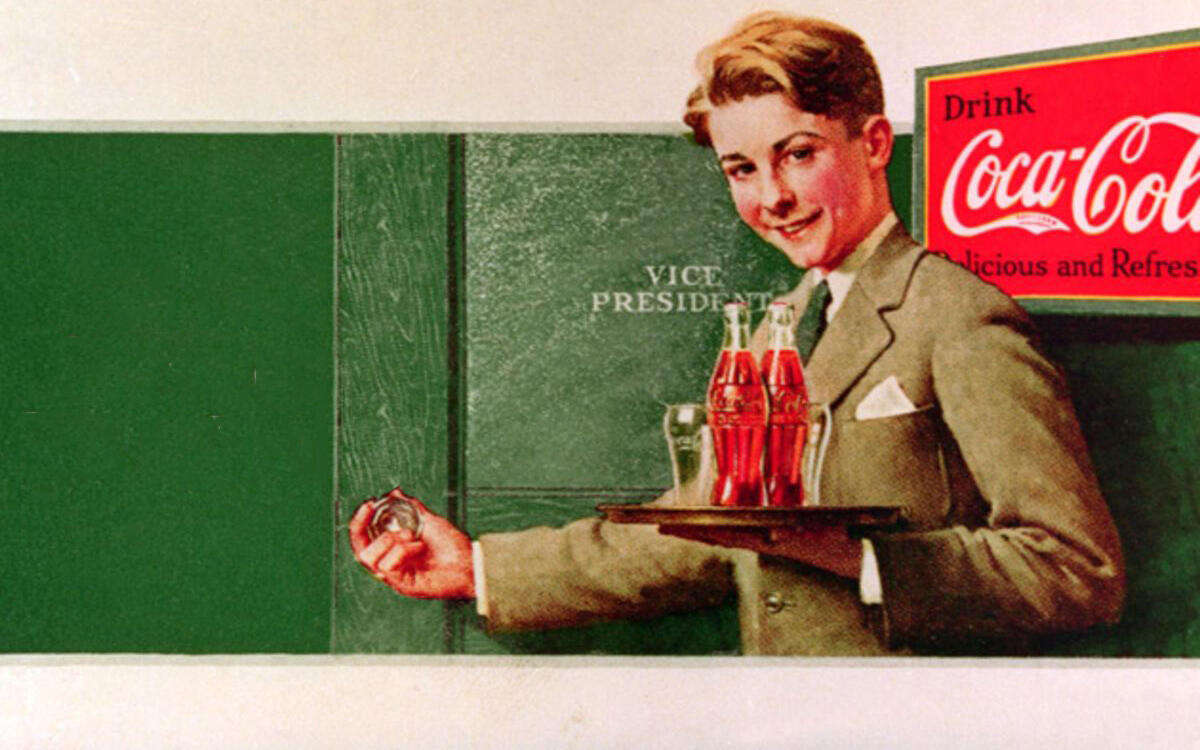Unleashing Your Creativity: The Art of DIY Shirt Printing
Have you ever marvelled at a uniquely designed t-shirt and thought, “I wish I could create something like that”? Well, guess what? You absolutely can! The world of DIY shirt printing is not just an avenue to unleash your inner artist; it's a delightful journey into the realms of personal expression and creative freedom. In this ultimate guide, we're diving headfirst into the captivating process of printing your own shirts, a path that leads to not only stunning garments but also an immensely rewarding experience.
This guide is your one-stop resource for everything you need to know about custom t-shirt printing. Whether you're looking to add a personal touch to your wardrobe, craft memorable gifts for friends and family, or even kickstart a small business venture, we've got you covered. We'll explore the various techniques of DIY shirt printing, from the traditional art of screen printing to modern digital methods. You'll learn about choosing the right materials, designing your prints, the actual printing process, and tips for maintaining the vibrancy of your creations.
Embarking on a DIY project, especially one as fun and creative as t-shirt custom printing, is not just about the end product. It's about the joy of creation, the satisfaction of learning a new skill, and the thrill of seeing your vision come to life on fabric. So, whether you're a seasoned DIY enthusiast or a curious beginner eager to 'print your own shirt', this guide promises to be a valuable companion on your creative journey.
Stay tuned as we unfold the secrets to transforming your ideas into wearable art, where each shirt becomes a canvas reflecting your unique style and vision. Welcome to the wonderful world of custom tee designs – where imagination meets reality!
Why Print Your Own Shirt?
A Canvas of Self-Expression: The Allure of Custom Tee Designs
In a world where individuality is increasingly cherished, printing your own shirt stands as a beacon of personal expression and creativity. But why should you embark on this journey of DIY shirt printing? The reasons are as colourful and varied as the designs you might imagine.
Personal Touch: Crafting a Unique Identity
One of the most compelling reasons to delve into custom tee designs is the unparalleled ability to infuse your personal touch into every creation. In a sea of mass-produced clothing, a self-printed shirt is a breath of fresh air, a statement of individuality. It's about more than just wearing a garment; it's about donning a piece of your personality, your thoughts, and your artistic flair.
This personalisation extends beyond just the aesthetic appeal. It's about telling a story, celebrating an event, or even showcasing your allegiance to a cause or a community. Each shirt becomes a conversation starter, a piece of wearable art that's bound to turn heads and spark curiosity.
Cost-Effective & Fun: The Joyful Economics of DIY
On the practical side, DIY shirt printing is a remarkably cost-effective venture. Whether you're upcycling an old tee or buying plain shirts in bulk, the cost of materials is often significantly lower than purchasing branded or designer wear. This affordability does not come at the expense of quality; in fact, it allows for a higher degree of control over the materials and techniques used, often resulting in a product that's tailor-made to your preferences.
Moreover, the process of designing and printing your own shirts is immensely enjoyable. It's a hobby that blends creativity with the satisfaction of tangible results. For the artistically inclined, it's a joyous playground; for beginners, it's a fun, engaging, and often therapeutic process that nurtures creativity.
A Venture into Entrepreneurship
Beyond personal use, DIY shirt printing opens doors to entrepreneurial opportunities. Custom tee designs have a steady and growing market, especially for unique, hand-crafted designs. This can be a lucrative side hustle or even grow into a full-fledged business, catering to individuals who value originality in their wardrobe.
Printing your own shirt is an enriching endeavour that goes beyond mere fashion. It's a means of self-expression, a cost-effective hobby, and potentially a profitable business venture. It's about bringing your ideas to life, one shirt at a time. So, why not grab some supplies, stir up your imagination, and start this creatively rewarding journey today?
Materials Needed
Gathering Your Toolkit: Essentials for Shirt Printing
Embarking on your DIY shirt printing journey begins with assembling the right tools and materials. The beauty of this craft lies in its versatility; you can start simple and expand your toolkit as you grow more skilled and ambitious in your designs. Here's a comprehensive list of supplies you'll need to get started with shirt printing:
List of Supplies:
-
Plain T-Shirts: Opt for high-quality, 100% cotton t-shirts for the best results. Cotton holds ink well and offers comfort and durability. Choose light-coloured shirts for beginners, as they are more forgiving with printing errors.
-
Screen Printing Kit: A basic kit typically includes a screen, a squeegee, and a photo emulsion. Kits come in various sizes and complexities, so select one that matches your skill level and project needs.
-
Inks: Fabric inks are essential for screen printing. Water-based inks are recommended for beginners due to their ease of use and clean-up. They also provide a soft finish on the fabric.
-
Stencil or Design: You can create a stencil manually or print a design using a computer and printer. The complexity of the design can vary based on your skill level.
-
Exposure Unit: For more advanced printing, an exposure unit is used to burn the design onto the screen. Beginners can use sunlight or a bright lamp as alternatives.
-
Washout Booth and Water Source: A washout booth or a similar setup is needed to clean the screens after printing. A garden hose or a sink with a strong spray nozzle can suffice for small-scale operations.
-
Drying Rack: A flat surface or a dedicated drying rack is needed to lay out the shirts to dry after printing.
-
Heat Press or Iron: This is used for curing the ink on the shirt to ensure durability. A standard iron can work for small-scale projects.
Choosing the Right Materials:
Selecting the best quality materials is crucial for achieving both aesthetic appeal and durability in your printed shirts.
-
Quality of T-Shirts: Look for shirts with a tight weave and a smooth surface. These will hold the ink better and result in a clearer print. Pre-washed shirts are preferable as they reduce the risk of shrinkage after printing.
-
Ink Selection: The choice of ink will impact the look, feel, and longevity of your print. Plastisol inks are durable and provide vibrant colours but require proper curing. Water-based inks are easier to work with and offer a softer hand feel but may fade faster.
-
Screen and Squeegee: The screen's mesh count determines the detail level in your design; higher mesh counts allow for more detail. The squeegee should be firm enough to evenly distribute ink across the screen.
-
Emulsion and Exposure: Choose a photo emulsion that's compatible with your light source. For beginners, look for user-friendly, pre-sensitized emulsions. Proper exposure is key to a crisp design, so invest time in mastering this step.
Having the right materials is the foundation of successful DIY shirt printing. While it's tempting to compromise on quality to save costs, investing in good materials pays off in the long run with superior prints and satisfied wearers. Whether you're a hobbyist or planning to sell your creations, the right tools will make your shirt printing journey smoother and more enjoyable.
Designing Your Shirt
Crafting Your Vision: The Art of Shirt Design
The process of designing your shirt is where creativity truly flourishes. This stage is all about bringing your vision to life, whether it's a vivid graphic, a catchy phrase, or an intricate pattern. Let's dive into the creative process and explore how you can translate your ideas onto fabric.
The Creative Process:
-
Conceptualisation: Start with an idea. What message or image do you want your shirt to convey? It could be inspired by a personal interest, a trending topic, or purely artistic expression. Sketch your ideas on paper or use digital tools for a more refined design.
-
Digital Design Tips: If you're using digital design software (like Adobe Illustrator or Photoshop), consider the following:
- Resolution: Ensure your design is created at a high resolution (at least 300 dpi) to ensure clarity when printed.
- Colours: Keep in mind the colour theory. Use contrasting colours for readability and aesthetic appeal. Also, remember that the colours on your screen might look different when printed, especially on different fabric colours.
- Simplicity vs Complexity: While intricate designs can be stunning, they might be more challenging to print, especially for beginners. Start with simpler designs and gradually progress to more complex ones.
-
Typography and Graphics: If your design includes text, choose legible fonts that complement the overall design. For graphics, vector images are preferred as they can be scaled without losing quality.
Transfer Methods:
-
Screen Printing: This traditional method involves creating a stencil (or screen) and using it to apply layers of ink on the printing surface. Each colour is applied using a different stencil, one at a time, combined to achieve the final look.
- Pros: Durable and high-quality prints; cost-effective for large batches.
- Cons: Setup can be complex for beginners; not ideal for super detailed multi-colour designs.
-
Heat Transfer: This method involves printing your design on special transfer paper and then applying heat and pressure to transfer the image to the shirt.
- Pros: Great for detailed and colourful designs; easier for small quantities or one-offs.
- Cons: Print durability can be less than screen printing; requires a heat press for best results.
-
Direct to Garment (DTG): This is like using a printer to print directly on the shirt. It's great for highly detailed designs and a wide range of colours.
- Pros: Excellent for high-detail, full-colour designs; minimal setup required.
- Cons: Generally more expensive; not as cost-effective for large batches.
Designing your shirt is an exciting and creative process that allows you to express your unique style and message. Whether you prefer the classic approach of screen printing or the modern techniques like heat transfer and DTG, the key is to start with a solid design and choose the method that best suits your vision and resources. Remember, each method has its nuances, so consider your design's complexity, colour requirements, and the quantity you plan to produce when making your choice. Happy designing!
The Printing Process
From Design to Fabric: Mastering the Art of Shirt Printing
The journey from a digital or sketched design to a beautifully printed shirt involves several key steps. This section will walk you through the printing process, providing a detailed guide to ensure your venture into shirt printing is both enjoyable and successful.
Step-by-Step Guide:
-
Preparing Your Workspace: First, set up a clean, dust-free area for printing. Ensure you have all materials at hand – the screen, squeegee, inks, and your pre-washed t-shirts.
-
Preparing the Screen (For Screen Printing): If you're using screen printing:
- Coat the screen evenly with photo emulsion in a dark room.
- Place your design on the screen and expose it to light to develop the stencil.
- Wash out the unexposed emulsion to reveal your design.
-
Setting Up the Shirt: Place your shirt on a flat surface, ideally a printing board or table. Use small weights or clamps to keep the fabric taut.
-
Applying the Ink:
- For screen printing, position the screen over the shirt where you want your design.
- Pour a line of ink along the top of the screen.
- Using the squeegee, firmly and evenly pull the ink across the screen, pressing it through the mesh onto the shirt.
-
Curing the Ink:
- After printing, the ink must be cured or set.
- For water-based inks, you can use a standard iron. Heat press machines are ideal for larger quantities or plastisol inks.
- Follow the ink manufacturer’s instructions for temperature and duration.
-
Drying the Shirt: Lay the printed shirt on a flat surface or hang it up to air dry. Avoid direct sunlight or high heat unless specified for curing.
-
Cleaning Up: Clean your screen and tools immediately after printing, especially if using plastisol inks.
Tips and Tricks:
- Test Print: Always do a test print on a similar fabric or an old shirt to check the design and colour output.
- Ink Consistency: Ensure the ink is the right consistency – not too thick or too runny.
- Squeegee Angle and Pressure: Hold the squeegee at a 45-degree angle and apply consistent pressure for an even print.
- Preventing Bleed: Use a spray adhesive on the printing board to prevent the shirt from shifting during printing.
Visuals:
- Images or Videos: Including images or videos of each step can be immensely helpful. For instance, show the process of coating the screen with emulsion, the squeegee technique, and the method of curing the ink.
- Infographics: An infographic summarizing the steps can be a quick reference for readers.
The process of printing your shirt, while intricate, is incredibly rewarding. With patience and practice, you’ll refine your technique and produce high-quality prints. Remember, every print offers a learning opportunity, so don’t be disheartened by initial imperfections. Embrace the process, and with each shirt, you'll see your skills and confidence grow. Happy printing!
Aftercare and Maintenance
Preserving Your Masterpiece: Tips for Long-Lasting DIY Shirts
After you've put in the effort to design and print your own shirts, it's crucial to know how to care for them properly. Proper aftercare ensures that your designs remain vibrant and the shirt stays in good condition for as long as possible. Here's a comprehensive guide on how to care for your DIY shirts and troubleshoot common issues.
Caring for Your DIY Shirt:
-
Washing Guidelines:
- Wait Before Washing: Allow the ink to fully cure before washing the shirt. This usually takes about 24-48 hours.
- Turn Inside Out: When washing your printed shirts, turn them inside out to protect the print.
- Use Cold Water: Wash the shirts in cold water to prevent the ink from bleeding and to reduce energy consumption.
- Gentle Cycle or Hand Wash: Use a gentle wash cycle or hand wash to avoid excessive agitation, which can damage the print.
- Mild Detergent: Use a mild, bleach-free detergent to avoid fading the print.
-
Drying:
- Air Dry Preferably: If possible, air dry the shirts by hanging them or laying them flat. Avoid direct sunlight.
- Low Heat if Machine Drying: If you must use a dryer, opt for a low heat setting. High heat can cause the ink to crack.
-
Ironing:
- Avoid Direct Ironing on Print: If you need to iron the shirt, do not iron directly on the print. Use a low heat setting and iron inside out or place a cloth over the print.
Troubleshooting Common Issues:
-
Fading Print:
- Cause: Often due to improper curing or harsh washing.
- Solution: Ensure proper curing of the ink and follow gentle washing guidelines.
-
Cracking Design:
- Cause: Cracking can occur if the ink is not cured properly or if exposed to high heat in the dryer.
- Solution: Cure the ink as per the manufacturer’s instructions and avoid high heat when washing and drying.
-
Ink Bleeding:
- Cause: Can happen if the ink is over-saturated or if the shirt is washed in hot water.
- Solution: Ensure proper ink application during printing and always wash in cold water.
-
Peeling Print:
- Cause: Usually a result of inadequate curing or using low-quality materials.
- Solution: Double-check curing processes and invest in high-quality printing materials and inks.
Taking care of your DIY printed shirts is not overly complicated but requires attention to detail. By following these aftercare tips, you can ensure that your custom tee designs remain as striking and vibrant as the day you printed them. Remember, each shirt is not just a garment; it's a personal creation that deserves to be preserved. With the right care, your DIY shirts can be long-lasting treasures that showcase your creativity and skill.
Conclusion
Embarking on a Creative Journey: The World of DIY Shirt Printing
As we reach the end of our comprehensive guide to DIY shirt printing, let’s take a moment to recap the key points and insights we've explored. This journey has taken us through the various facets of creating custom tees, from the initial design stages to the final touches of aftercare and showcasing.
Recap of Key Points:
-
Introduction to DIY Shirt Printing: We started by diving into the creative and personal aspects of printing your own shirts, highlighting the unique blend of artistry and self-expression this craft offers.
-
The Appeal of Custom Tee Designs: We discussed the benefits of custom shirt printing, including the personal touch it adds and its cost-effectiveness, whether as a hobby or a potential business venture.
-
Materials Needed: We listed the essential materials and tools required for shirt printing, emphasising the importance of selecting high-quality items for the best results.
-
Designing Your Shirt: Here, we explored the creative process of designing artwork for your shirts, including tips for digital design and different transfer methods like screen printing, heat transfer, and direct to garment printing.
-
The Printing Process: This section provided a detailed, step-by-step guide to the actual printing process, accompanied by expert tips and tricks for achieving high-quality prints.
-
Aftercare and Maintenance: We covered the crucial steps for caring for your printed shirts, ensuring they remain vibrant and intact, along with troubleshooting common issues that might arise.
-
Showcase and Inspiration: Lastly, we highlighted the importance of showcasing your work and finding inspiration from others, encouraging a community spirit among DIY shirt printing enthusiasts.
Now that you are equipped with the knowledge and inspiration to start your own DIY shirt printing journey, we encourage you to take the plunge. Whether it's to express your personal style, create gifts for loved ones, or even start a new business venture, the world of custom tee designs is rich with possibilities.
We would love to see what you create! Share your designs, successes, and even the learning moments with us. If you have any questions, need advice, or want to show off your creations, don't hesitate to reach out. Your stories and designs could inspire others and contribute to the ever-growing community of DIY shirt printing enthusiasts.
Remember, every great journey begins with a single step. So, grab your materials, fire up your imagination, and start printing! Your next masterpiece is just a print away. Happy printing!








Comments (0)
Add a Comment